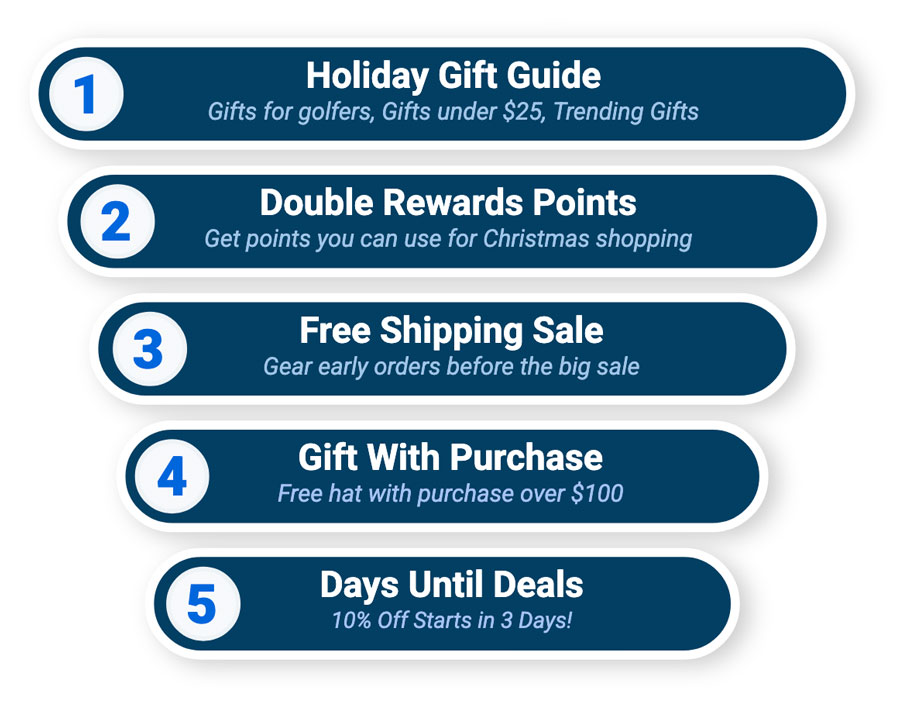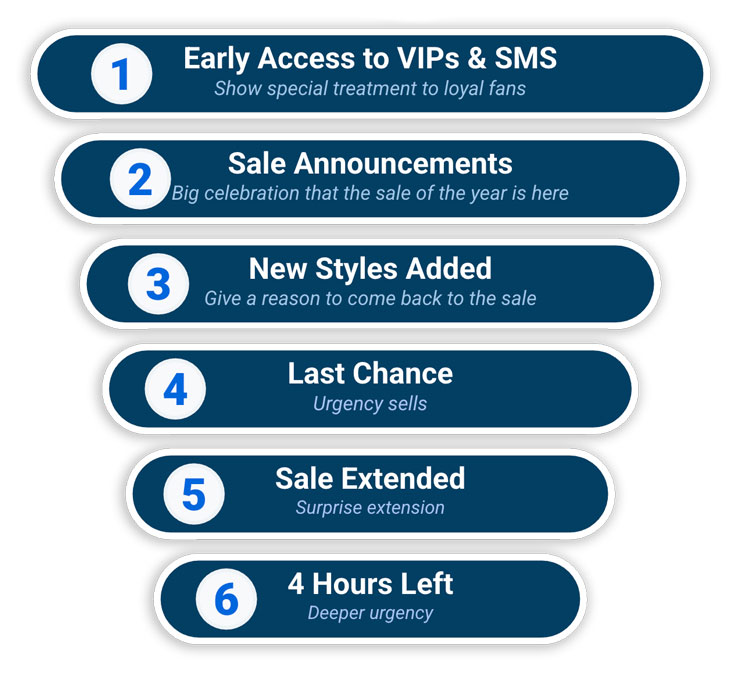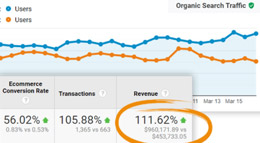Holiday Marketing Guide 2025: How to Prepare, Execute, and Extend Your Results

We don’t need to tell you how critical the holiday season is for revenue. Sadly, it is not “the most wonderful time of the year” for every eCommerce business. Only the brands that start early and execute with precision will achieve their desired revenue goals. Time’s ticking.
OuterBox has you covered. Here, we unwrap proven holiday marketing strategies, from pre-season planning to post-holiday loyalty building. These seasonal strategies will help drive results across channels, allowing you to wrap up your 2025 revenue goals with a bow.
Summer is the Season for Holiday Planning
It’s weird to think of turkeys and snow in the summertime, but that’s what the pros do to get ready for the busiest shopping season. Why?
Thanksgiving falls late this year, on November 27th, so we only have 26 days between Black Friday and Christmas. This year is one of the shortest holiday shopping windows on record, with the average time being between 27 and 30 days.
You’ll also want a longer runway to hit revenue goals. A survey on last year’s consumer behavior shows nearly 50% of shoppers started before October. Additionally, shoppers are becoming increasingly deal-sensitive due to inflation, stagnant wages, and a slower labor market.
According to a report from Klaviyo, last year, many brands began launching Black Friday/Cyber Monday promotions on November 7th. The email platform recommends starting well before November to “capture early demand and alleviate consumer budget constraints.”
Remember: Mobile-first remains the dominant shopping trend. It’s where most consumer research starts. While not a shock, it’s important to consider that this behavior involves spreading purchase decisions across multiple channels over time, including LLMs (Large Language Models) and AIOs (AI Overviews). This requires brands to deliver consistent brand experiences everywhere.
If you’re late to the game, you’ll need to accelerate your foundation building to get caught up, but don’t let speed overshadow strategy.
How to Build Your Holiday Marketing Foundation
This foundation-building should not be a waterfall approach. You’ll want to set the foundations for SEO, UX, paid media, and email in sync. To do this, align holiday goals across these areas by identifying your gift buyers, holiday deals, and promotions for milestones like Black Friday. Now is the time to align with your product and operations teams to avoid surprises. Having other teams approaching you in November about running a black friday deal is far from ideal. Understand the promotion pushes and inventory capabilities now, then tell the whole organization.
Having goals ladder up to all marketing tactics makes synergy a cinch come crunch time. Here’s a checklist for each channel to help build your pre-holiday marketing foundation:
SEO Holiday Checklist
- Seasonal Keyword Expansion: Once terms like “holiday deals” and “Black Friday” are covered, build keyword sets around other holiday activities such as shipping cutoff queries (“delivery by December 24th”), gift idea modifiers (“gifts for car enthusiasts”), and urgency intent (“last-minute” and “near me” queries).
- Holiday Landing Page Strategy: Create dedicated holiday pages like /black-friday, /holiday-gift-guide, and /cyber-monday, and keep them live year-round to build authority. Update annually with fresh content, promos, and products. Then you can hide them from the main navigation in the off-season. Add internal links from homepage banners, navigation menus, and blog posts to funnel authority to your seasonal hubs.
- Rich Media and Schema for Holiday SERPs: Implement product schema and offer schema to highlight seasonal discounts directly in search results. You can include holiday-specific attributes such as price (normal price), priceValidUntil (end date of the holiday promotion), availability (“InStock” or “OutOfStock”), and offers with holiday sale details (e.g., Cyber Monday deal, 20% off). Use FAQ schema around common holiday-specific concerns: return policies, delivery timelines, and gift wrapping availability. Add structured data for promotions to enable rich snippets, such as sale start and end dates.
- Seasonal Content Hooks: Build gift guide content by interest and optimize for long-tail queries. For example, “10 holiday stocking stuffers for Dad”. Publish “holiday survival” articles that tie to your product. For instance, “How to keep your car road-trip ready this holiday”, if you offer automotive products.
- Capture Early and Late Buyers: Optimize for early planners in October with “early Black Friday deals” content. Refresh meta titles/descriptions in December for last-minute urgency with content like, “Still shopping? Order today for guaranteed Christmas delivery”.
PPC Holiday Campaign Prep
- Audience Layering: Build remarketing lists to layer intent-based audiences like “cart abandoners in the last 90 days” or “seasonal deal-seekers” who engaged with holiday terms last year.
- Ad Copy Customization: Rotate copy that taps into urgency (“order before December 15th for guaranteed delivery”) and tailor messaging by device—mobile ads can focus on quick buys, while desktop ads can highlight bundles or reviews.
Holiday Extensions: Use ad extensions creatively. Think of sitelinks for gift guides, promotion extensions for Black Friday/Cyber Monday, and countdown timers to push urgency.

Examples of ads addressing various stages of the season.
Segmentation and Personalization for Holiday Emails
- Behavior-Based Flows: Set up automations like gift reminder sequences, “stocking stuffer” highlights, and post-purchase upsell flows tailored to holiday urgency.
- Dynamic Content Blocks: Show different hero banners, products, or CTAs based on purchase history and demographics like location. For example, cold-weather products for northern customers vs. southern markets.
- Send-Time Optimization: Use AI-driven send-time testing so your emails land when your audience is most active based on data in your email platform.
Optimize UX for Holiday Shoppers
- Pause Testing: We typically don’t recommend A/B testing during peak months, so if you have any tests still running, or any waiting on the bench, it’s best to get those out the door now so you can have winning variations in place when your traffic spikes.
- Simplify checkout: Reduce steps, add guest checkout, and highlight payment options like Apple Pay or Google Pay for faster conversions.
- Clarify shipping and returns: Prominently display holiday shipping cutoffs and return deadlines on cart and checkout pages.
- Mobile-first design: With holiday shoppers browsing on the go, ensure buttons, forms, and promo banners are thumb-friendly and above the fold.
- Highlight urgency: Use subtle UX cues—stock counters, delivery countdowns, or “order by X date”—to reinforce seasonal urgency without being disruptive.
Bringing it all together, holiday success isn’t about doing more across every channel—it’s about tailoring each one to the season’s unique behaviors and expectations. By pairing SEO with seasonal intent, PPC with smart audience building, email with personalization, and UX with friction-free shopping, you’ll be positioned to capture demand when it peaks.
Channel-Specific Holiday Marketing Tactics
With the foundation in place, it’s time to execute. These channel-specific tactics show how to apply your prep in real time—shifting landing pages by week, refreshing creative with urgency, scaling automations, and layering personalization as shopping intensity builds.
There are three distinct shifts that you should plan for in these applications:
- “The Cyber 5”: The five days bookended by Thanksgiving and Cyber Monday (including Black Friday).
- Mid-season: This is post-Cyber Monday and before the final countdown for shipping around mid-December. Average holiday shopping and month-long/timed promotions with opportunities for promoting gift guides, curated listing pages, and daily deal changes.
- Late shoppers: Last-minute deals, quick delivery, or in-store deals.
Small changes in campaign displays can make a significant impact on your customers with more timing-specific messaging.

Building momentum with phased holiday marketing campaigns.
Phase Holiday Landing Pages for Key Shopping Windows
Shift your landing page content throughout the season—early deals in October/early November, Cyber 5 hero offers, mid-season gift guides, last-minute shipping, and BOPIS messaging (Buy Online, Pick Up In Store) in December. Keep the evergreen page framework, but rotate content to match shopper intent at each stage.
Fun Fact: Last year between November 14 and December 25, Lowe’s changed promotions on its homepage 18+ times. One of its promotions, the “10 days of Deals for Pros,” featured a new homepage each day. Even small retailers should refresh pages a few times during the season to keep things interesting.
Optimize Product Feeds for Holiday Visibility
Keep Google Merchant Center and Microsoft Merchant Center fully updated, include seasonal attributes (such as gift tags and holiday bundles), and monitor AI-driven product displays so your listings appear in AIOs and shopping carousels.
Refresh Seasonal Ad Creative and Extensions Frequently
Build ad creative in advance so you can pivot quickly during peak weeks. Use countdown extensions, promotion extensions, and mobile-first creative swaps. Even small text/image changes every few days keep repeat visitors engaged. You may not use every variation, but having them premade and on hand gives you flexibility as you spot new trends in your buyers and your competition.
Scale Email Automations as Shopping Intensifies
Move from basic list segmentation into layered automations. Example: early welcome series in October, abandonment flows during Cyber 5, and loyalty/referral campaigns in December.
A common question asked, “How much email is too much?”. Our tip is the 1% Rule: if the final email in any automation has a placed order rate above 1%, add another message. That 1% signals buyer interest.

Volume drives sales. Email personalization nudges them higher.
Personalize Holiday Campaigns with Segments that Drive Action
Take personalization beyond “first name” by building VIP, early-access, and high-value buyer segments. Trigger SMS exclusives, volume-based discounts, or category-specific promotions that feel like a tailored offer, not a generic blast.

Additional phased holiday marketing campaigns to consider.
The magic isn’t in one channel, but in how each tactic plays off the others so your brand is visible, relevant, and conversion-ready from October through December.
Execute Your Campaign Launch With Precision
Your holiday launch is the moment when all the planning, foundation work, and channel tactics come together. This isn’t just about turning campaigns on—it’s about orchestrating them with precision so every shopper sees the right offer at the right time.
Here’s your launch-week checklist to keep campaigns sharp and sales flowing:
- Flip the Homepage: Make your branded holiday landing page the homepage 1–2 weeks before Black Friday. Dedicate it fully to holiday deals, gift guides, and seasonal promotions.
- Keep Creative Fresh: Refresh banners, promotions, and ad creative frequently—sometimes daily during Cyber 5. Even small text swaps or new hero images keep repeat visitors engaged and signal momentum.
- Coordinate Across Channels: Align offers across email, paid ads, and site promotions so shoppers see consistent messaging wherever they interact with your brand.
- Prioritize What’s Available: Highlight in-stock products, limited-time doorbusters, or quick-ship items to drive urgency while reducing customer disappointment.
- Use Urgency Cues: Leverage countdown timers, delivery cutoff banners, and “last chance” flags on product and cart pages to nudge faster conversions without overwhelming shoppers.
- Monitor & Pivot in Real Time: Keep a pulse on performance, inventory, and competitor offers. Be ready to pivot promotions or shift budget quickly during Cyber 5 to capture surging demand.
Launching with precision is critical, but the brands that truly maximize holiday ROI know the season doesn’t stop at midnight on December 24th. The days and weeks that follow are just as important—and with the right post-holiday playbook, you can turn year-end shoppers into loyal customers well into the new year.
Don’t Forget the Post-Holiday Playbook
January can be one of the strongest months for revenue if you plan for it. Customers are redeeming gift cards, exchanging items, and shopping for themselves—all opportunities to extend your Q4 momentum into Q1.
Here’s your post-holiday checklist to maximize results:
- Gift Card Redemptions: Promote gift card use with limited-time offers or bonus rewards. Encourage shoppers to spend them quickly to drive early Q1 sales.
- Self-Gifting Campaigns: Shoppers often “buy for themselves” after the holidays. Highlight popular products, upgrades, or premium add-ons as the perfect treat.
- Streamlined Returns and Exchanges: Make returns hassle-free. Promote easy exchanges as a way to keep customers engaged with your brand.
- Post-Holiday Promotions: Clear out leftover inventory with strategic discounts. Position these as “New Year savings” rather than clearance, keeping your brand aligned with value and optimism.
- Build Long-Term Loyalty: Use post-purchase flows to ask for reviews, enroll customers in loyalty programs, and re-engage them with personalized recommendations.
The holiday season is short, intense, and full of competition—but it’s also the single biggest opportunity to hit and exceed your revenue goals. The brands that win are the ones that start early, plan smarter, and stay agile across every channel. By laying the right foundation, executing channel tactics with precision, and carrying momentum into the post-holiday period, you’ll not only maximize sales in Q4—you’ll set the stage for long-term customer loyalty and growth well into the new year.
Commit to Continuous Improvement
The best brand stories aren’t static. They evolve as markets, technologies, and customer needs shift. Treat storytelling as an iterative process, where each campaign refines your narrative and strengthens your position in the market.
At OuterBox, we help B2B brands turn their data into compelling stories that win buy-in, build trust, and drive measurable growth. When you ground your marketing in strategic storytelling, you don’t just present numbers—you make them matter.



